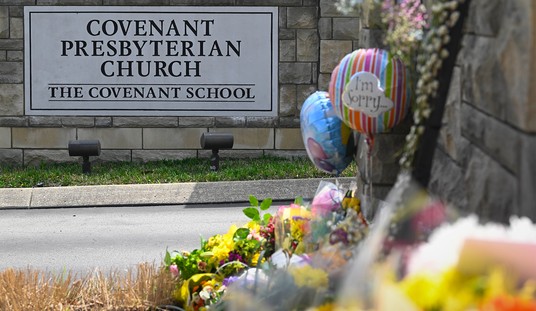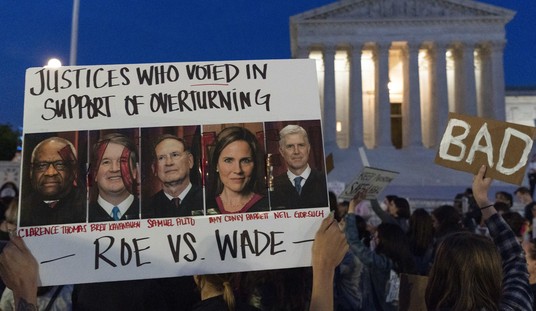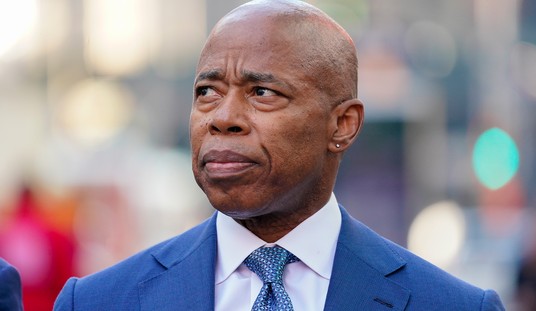
Deputy Attorney General-designate, federal prosecutor Rod Rosenstein, listens on Capitol Hill in Washington, Tuesday, March 7, 2017, during his confirmation hearing before the Senate Judiciary Committee. (AP Photo/J. Scott Applewhite)
Judicial Watch announced today they had obtained a copy of a memo written by then-Acting FBI Director Andrew McCabe on May 16, 2017. This memo is McCabe’s “contemporaneous recollection” of the infamous meeting held in then-Deputy Attorney General Rod Rosenstein’s office during which Rosenstein had allegedly proposed wearing a wire to record the President. (The document, which is lightly redacted, is printed below.)
In addition to Rosenstein and McCabe, Deputy Assistant AG for Intelligence Tashina Gauhar and Principal Associate Deputy Attorney General Jim Crowell attended the meeting.
McCabe touched only briefly on Rosenstein’s idea of wearing a wire. Although it was brief, for Rosenstein, it was damning. He wrote:
As our conversation continued the DAG proposed that he could potentially wear a recording device into the Oval Office to collect additional evidence on the President’s true intentions. He said he thought this might be possible because he was not searched when he entered the White House. I told him that I would discuss the opportunity with my investigative team and get back to him.
In September 2018, The New York Times reported that during this meeting, the group had supposedly discussed the possibility of invoking the 25th Amendment to remove Trump from office. In addition, Rosenstein allegedly offered to wear a wire to record his conversations with Trump and said he knew of one or two members of Trump’s cabinet who might be on board with such a plan.
McCabe makes no mention of the 25th Amendment, likely because the idea was preposterous and he may have assumed his memo might be referenced in the future.
Rosenstein has publicly maintained that he was being sarcastic when he made this comment. But nothing in McCabe’s memo suggests Rosenstein was being sarcastic. Rather, McCabe wrote he told Rosenstein that he would “discuss the opportunity with my investigative team and get back to him.”
The fact that Rosenstein had gone as far as thinking about practical details such as ‘I am not searched when I enter the White House’ indicates his seriousness. This remark shows that Rosenstein had at least given the idea some thought.
The idea of wearing a wire comes up in the middle of the meeting, but the group discussed other topics as well.
McCabe began by telling Rosenstein that he “approved the opening of an investigation of President Donald Trump … to investigate allegations of possible collusion between the president and the Russian Government, possible obstruction of justice related to the firing of FBI Director James Comey, and possible conspiracy to obstruct justice.”
He told Rosenstein that the predication for his investigation was based on Trump’s interview with NBC’s Lester Holt and “concurring statements” from Comey’s memos.
McCabe expressed concern that Rosenstein, “as a result of his role in the matter, I thought he would be a witness to the case.” (If Rosenstein had been considered a witness in the case, he would have had to recuse himself from overseeing a potential special counsel investigation as then-Attorney General Jeff Sessions had already done.)
Rosenstein then recounted his Oval Office meeting with Trump, Sessions and then-White House Counsel Don McGahn about Comey’s imminent firing. He said the President asked him to write a “memo explaining the reason” for Comey’s firing.
Rosenstein told McCabe he had a “credibility problem.” One of Rosenstein’s staffers had shown him photos of McCabe wearing his wife’s campaign t-shirt after “assuring” the DOJ he played no role in her campaign.
They discussed the possibility of appointing a Special Counsel to conduct the investigation. Rosenstein said he already had two candidates in mind and that one could start right away. In fact, on May 17, 2017, the very next day, Rosenstein appointed Robert Mueller to the Special Counsel.
Judicial Watch President Tom Fitton said, “This incredible memo details the conflicted and conniving coup effort against President Trump. It is astonishing and shocking McCabe thought he could have the FBI conduct a ‘counterintelligence’ operation on the president and Rosenstein thought it would be appropriate to wear a wire to secretly record President Trump in the Oval Office. That the DOJ and FBI sat on this smoking gun for a year shows the need for urgent housecleaning at those agencies.”
I’ve never understood why Rod Rosenstein, who has played such a pivotal role in the investigation of President Trump has received so little media attention. The matter of whether or not he volunteered to wear a wire is only part of what he must answer for. He needs to be asked why he appointed a Special Counsel when there was no evidence of collusion in May 2017. FBI attorney Lisa Page admitted during her Congressional testimony last summer that the FBI had no evidence as late as May 2017 that Trump had colluded with Russia. Why did he do it?
Why did he allow Mueller to expand the scope of the investigation? What, if any, evidence did Rosenstein require from Mueller to expand the scope? Was there ever a Mueller request that Rosenstein said no to?
It was Rosenstein’s role to supervise the activities of the Special Counsel, and his apparent submission to Mueller suggests that Mueller was actually driving the bus.
His role must be examined.
Here is the full text of the redacted McCabe memo (via Judicial Watch):
Tuesday, May 16, 2017
At 12:30 pm on 05/16/2017, I met with Deputy Attorney General (DAG) Rod Rosenstein in his office at the Department of Justice. Also present were Tashina Gauhar and Jim Crowell. The following is a contemporaneous recollection of the main topics we discussed.
I began by telling him that today I approved the opening of an investigation of President Donald Trump. I explained that the purpose of the investigation was to investigate allegations of possible collusion between the president and the Russian Government, possible obstruction of justice related to the firing of FBI Director James Comey, and possible conspiracy to obstruct justice. The DAG questioned what I meant by collusion and I explained that I was referring to the investigation of any potential links between the Trump campaign and the Russian government. I explained that counterintelligence investigations of this sort were meant to uncover any existence of any threat to national security as well as whether or not criminal conduct had occurred. Regarding the obstruction issues, I made clear that our predication was based not only on the president’s comments last week to reporter Lester Holt (that he connected the firing of the director to the FBI’s Russia investigation), but also on the several concurring comments the president made to Director Comey over the last few months. These comments included the President’s requests for assurances of loyalty, statements about the Russia investigation and the investigation of General Michael Flynn. I also informed the DAG that Director Comey preserved his recollection of these interactions in a series of contemporaneously drafted memos. Finally, I informed the DAG that as a result of his role in the matter, I thought he would be a witness in the case.
The DAG then related his experiences at the White House on Monday, 05/08/2017. He began by stating that he had the feeling that the decision to fire the Director had been made before he arrived. At the White House, he first met with White House Counsel Donald McGahn, who told him that the President had drafted a letter to Director Comey that McGahn did not want the President to send. Shortly thereafter they met with the President and Attorney General Jeff Sessions, and possibly others, in the Oval Office. President Trump told the DAG he had written a letter to Director Comey, asked the DAG if he had seen the letter, and instructed McGahn to provide the DAG with a copy. The DAG described the letter to me as being a long list, possibly several pages, of the President’s complaints with Director Comey. Among those complaints was a discussion about the FBI’s Russia investigation, as well as a paragraph about the FBI Deputy Director. The DAG indicated to me that he retained a copy of the President’s letter. The DAG said he told the President [redacted]. The President then directed the DAG to write a memo explaining the reasoning for Director Comey’s termination and that the DAG should include Russia. The DAG said to the President he did not think this was a good idea and that his memo did not need to include Russia. The President replied that he understood, but that he was asking the DAG to include Russia anyway. As our conversation continued the DAG proposed that he could potentially wear a recording device into the Oval Office to collect additional evidence on the President’s true intentions. He said he thought this might be possible because he was not searched when he entered the White House. I told him that I would discuss the opportunity with my investigative team and get back to him.
We discussed the issue of appointing a Special Counsel to oversee the FBI’s Russia investigation. The DAG said he has two candidates ready one of whom could start immediately. [Redacted] The DAG said that he left a copy of the delegation with Acting Assistant Attorney General for National Security Dana Boente to execute in the DAG’s absence if the DAG were suddenly removed from his position. [Redacted] He anticipated that he may be terminated when he puts the Special Counsel in place, in light of the president’s anger with AG Sessions when the AG recused himself from the Russia investigation. The DAG further stated that he was told that others heard the President tell the AG “you were supposed to protect me.”
[Redacted]
The DAG related to me that on Sunday, 05/14/17, the AG asked him to participate in the interview of [redacted] for the position of FBI Director. [Redacted].
The DAG told me that he informed the AG that I should remain in my role as Acting Director until the permanent Director was chosen. The DAG opined that my only “problem” was that some people believe that I was involved in my wife’s 2015 campaign for State Senate in Virginia. The DAG said it was a “credibility problem” because after having told him during my May 13 interview that I played no role in her campaign and attended no campaign events, the DAG said a staffer had provided him with a photograph found on the internet of me and my wife wearing Dr. Jill McCabe campaign t-shirts. The DAG suggested that this photograph contradicted my statement that I had not campaigned for my wife. I pointed out to the DAG that the photograph he saw was taken not at a campaign event, but rather at [redacted] I further informed the DAG that I confirmed with my ethics counsel at FBI that the Hatch Act does not prohibit wearing a campaign button or shirt away from the office, and that attending [redacted] wearing such a shirt does not constitute proscribed political activity.













Join the conversation as a VIP Member